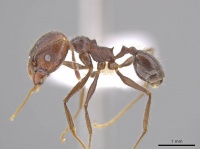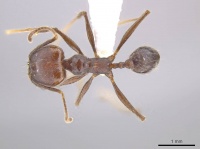Pheidole indagatrix
| Pheidole indagatrix | |
|---|---|

| |
| Scientific classification | |
| Kingdom: | Animalia |
| Phylum: | Arthropoda |
| Class: | Insecta |
| Order: | Hymenoptera |
| Family: | Formicidae |
| Subfamily: | Myrmicinae |
| Tribe: | Attini |
| Genus: | Pheidole |
| Species: | P. indagatrix |
| Binomial name | |
| Pheidole indagatrix Wilson, 2003 | |
According to Longino (1997), indagatrix occurs in moist to wet forests, both on the ground and in the canopy, and forages both day and night. It is equally flexible in nesting sites, with colonies having been found variously in and under dead wood on the ground, and in one case each, under accreted soil on the side of a tree trunk and in a hollow live stem. Winged males have been found in nests in January and March. (Wilson 2003)
Identification
See the description in the nomenclature section.
Keys including this Species
Distribution
A common species in Costa Rica from Meseta Central northward, up to 1500 m (Longino 1997).
Latitudinal Distribution Pattern
Latitudinal Range: 15.7440821° to 9.904666°.
| North Temperate |
North Subtropical |
Tropical | South Subtropical |
South Temperate |
- Source: AntMaps
Distribution based on Regional Taxon Lists
Neotropical Region: Costa Rica (type locality), Honduras, Nicaragua, Panama.
Distribution based on AntMaps
Distribution based on AntWeb specimens
Check data from AntWeb
Countries Occupied
| Number of countries occupied by this species based on AntWiki Regional Taxon Lists. In general, fewer countries occupied indicates a narrower range, while more countries indicates a more widespread species. |

|
Estimated Abundance
| Relative abundance based on number of AntMaps records per species (this species within the purple bar). Fewer records (to the left) indicates a less abundant/encountered species while more records (to the right) indicates more abundant/encountered species. |

|
Biology
Castes
Worker
Minor
Images from AntWeb
  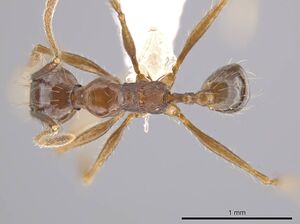 
| |
| Worker. Specimen code casent0618219. Photographer M. Pierce, uploaded by University of Utah. | Owned by JTLC. |
 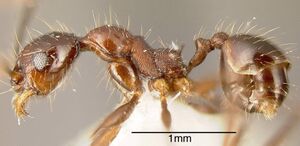 
| |
| Worker. Specimen code casent0635478. Photographer J. Longino, uploaded by University of Utah. | Owned by JTLC. |
Major
Images from AntWeb
   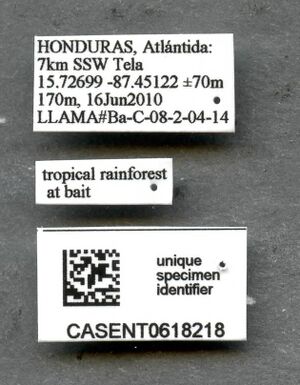
| |
| Worker (major/soldier). Specimen code casent0618218. Photographer M. Pierce, uploaded by University of Utah. | Owned by JTLC. |
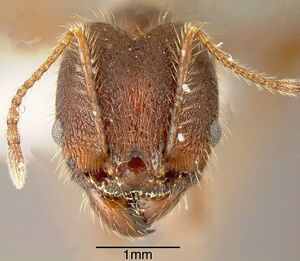 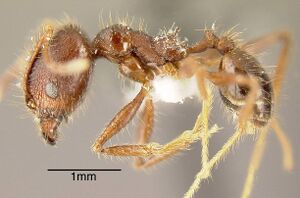 
| |
| Worker (major/soldier). Specimen code inbiocri002272029. Photographer J. Longino, uploaded by University of Utah. | Owned by JTLC. |
Nomenclature
The following information is derived from Barry Bolton's Online Catalogue of the Ants of the World.
- indagatrix. Pheidole indagatrix Wilson, 2003: 304, figs. (s.w.) COSTA RICA.
Unless otherwise noted the text for the remainder of this section is reported from the publication that includes the original description.
Description
A member of the fallax group with some similarities to Pheidole haskinsorum, Pheidole hector and Pheidole nubicola, distinguished as follows.
Major: antennal scape surpasses occipital corner by about its own maximum width; frontal lobes mostly rugoreticulate; pilosity dense and long over all the body, many hairs longer than Eye Length; rugoreticula mesad to each eye extend most of the way to the anterior border of head; all of posterior half of dorsal surface of head punctate and opaque, as well as most of pronotum; anterior half of central strip of first gastral tergite shagreened; propodeal spines long and thin; postpetiole from above diamond-shaped.
Minor: propodeal spines long and thin; pilosity dense, with many hairs as long as Eye Length; occiput narrow, with nuchal collar.
MEASUREMENTS (mm) Holotype major: HW 1.18, HL 1.26, SL 1.10, EL 0.20, PW 0.60. Paratype minor: HW 0.60, HL 0.80, SL 1.04, EL 0.20, PW 0.42.
COLOR Major: body and mandibles medium reddish brown; gaster medium brown; legs and antennae light reddish brown except for the tarsi, which are yellow.
Minor: body and mandibles medium reddish brown; rest of appendages yellowish brown.
Figure. Upper: holotype, major. Lower: paratype, minor. Scale bars = 1 mm.
Type Material
COSTA RICA: 3–5 km east of Turrialba, col. William L. Brown. Museum of Comparative Zoology
Etymology
L indagatrix, huntress.
References
- Wilson, E. O. 2003. Pheidole in the New World: A dominant, hyperdiverse ant genus. Harvard University Press, Cambridge, MA. (page 304, fig. major, minor described)
- Guerrero, R.J., García, E., Fernández, F. 2022. The Pheidole Westwood, 1839 ants (Formicidae: Myrmicinae) in Colombia: new records including two species with remarkable morphology. Zootaxa 5154 (3): 319-332 (doi:10.11646/zootaxa.5154.3.5).
References based on Global Ant Biodiversity Informatics
- Longino J. T. L., and M. G. Branstetter. 2018. The truncated bell: an enigmatic but pervasive elevational diversity pattern in Middle American ants. Ecography 41: 1-12.
- Longino J. T., and R. K. Colwell. 2011. Density compensation, species composition, and richness of ants on a neotropical elevational gradient. Ecosphere 2(3): 16pp.
- Longino J. et al. ADMAC project. Accessed on March 24th 2017 at https://sites.google.com/site/admacsite/
- Ottonetti L., L. Tucci, F. Frizzi, G. Chelazzi, and G. Santini. 2010. Changes in ground-foraging ant assemblages along a disturbance gradient in a tropical agricultural landscape. Ethology Ecology & Evolution 22: 7386.
